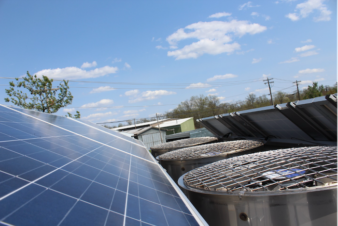 Dain Hansen is vice president of Government Relations, The IAPMO Group. He lends his frequent perspective of Capitol Hill, and the plumbing industry.
Dain Hansen is vice president of Government Relations, The IAPMO Group. He lends his frequent perspective of Capitol Hill, and the plumbing industry.
Here is an edited version of his update from July 31, 2015:
Senate Energy Bill Includes Funding Water-Energy Nexus. After three days of debate, the Senate Energy and Natural Resources Committee voted Thursday to approve its attempt at the first broad energy policy reform bill in eight years. The Energy Policy Modernization Act of 2015” (EPMA) includes language supported by IAPMO and prioritized by the High-Performance Buildings Congressional Caucus Coalition. Section 4101 of EPMA includes The NEWS Act, which would establish an Interagency Coordination Committee to identify all relevant energy-water nexus activities across the federal government; enhance the coordination of research and development activities among agencies; and gather and disseminate data to enable better energy-water nexus related practices. It would further establish the Nexus of Energy and Water Sustainability (NEWS) office to provide leadership and administrative support functions for the Interagency Coordination Committee. Another provision in the EPMA would require the Department of Energy to establish a smart energy and water efficiency pilot program that would award grants to a limited number of utilities, municipalities, and water districts for pilot projects that “demonstrate unique, advanced, or innovative technology-based solutions” to the water/energy nexus challenges. Clearing Committee was the first step in a longer journey, Sen. Murkowski now needs a commitment from Majority Leader Mitch McConnell for sufficient floor time and an amendment process that’s “fair and reasonable” – avoiding Keystone and anti-EPA amendments.
Portman-Shaheen Energy Efficiency Clears Committee…Again. In a separate vote, the Senate Energy and Natural Resources Committee also passed an energy efficiency bill that has come to be known as Portman-Shaheen. The bill from Sens. Rob Portman (R-Ohio) and Jeanne Shaheen (D-N.H.) would authorize funding for measures to increase energy conservation in federal data centers, establish voluntary national model building codes and boost energy efficiency in the manufacturing and commercial sectors, among other things. While most of the provisions in the Portman-Shaheen legislation were included in the Energy Policy Modernization Act of 2015, the committee moved forward with the stand-alone efficiency bill at the behest of Portman, who wants a backup plan if the broader energy legislation stalls. At yesterday’s hearing, Senator Portman pointed out that unlike the EPMA, Portman-Shaheen also includes the SAVE Act which would allow Federal mortgage agencies to include a home’s expected energy cost savings when determining the value and affordability of energy efficient homes. These provisions would also create appraisal guidelines to ensure that energy efficient upgrades are reflected in appraisals. The third time could be the charm. Previous versions of the bill have been brought to the Senate floor in the past but have stalled amid fights over amendments.
WaterSense Program Authorization Included In New Drought Bill. Sens. Dianne Feinstein and Barbara Boxer introduced the California Emergency Drought Relief Act on Thursday. The bill contains short- and long-term provisions designed to help communities cope with the ongoing drought and combat future droughts. According to Feinstein’s office, the bill is the product of months of meetings between Senator Feinstein’s staff, federal, state and local officials, environmental groups, water districts and other stakeholders. “I’m hopeful the bill we’re introducing today will serve as a template for the kinds of short-term and long-term solutions California needs to address this devastating drought,” Senator Feinstein said. “Next steps for this bill will include a public committee hearing in the fall, after which I expect California-specific language will be folded into a broader Western drought bill in the Energy Committee. In the meantime, my staff will continue to collect feedback on ways to improve and build on the bill.” Among other provisions, the legislation would authorize EPA’s WaterSense program. Senator Boxer had previously introduced a bill that authorizes the same EPA program.
EPA Will Ease Deadlines On Clean Power Rule To Help States Comply. According to several sources, the Obama administration is expected to give states more time to comply with proposed regulations that will require dramatic cuts in greenhouse-gas pollution from power plants. At the same time, the EPA will offer credits and other inducements to encourage a rapid shift to renewable energy under the Clean Power Plan, the administration’s ambitious and controversial proposal to cut pollutants blamed for climate change. The revelations come less than a week before the administration is expected to announce the final version of the regulation, which has been under heavy assault by congressional Republicans, the fossil-fuel industry and numerous state governments. Opponents contend that the regulation will severely damage the coal industry while raising electricity rates for consumers. The proposal the EPA initially introduced in June 2014 called for each state to develop a plan for dramatically reducing greenhouse-gas emissions from coal-fired power plants by 2030. This debate is not over yet, a number of states have complained to the EPA that the new rules will force them to shut down coal-burning power plants ahead of schedule, resulting in higher utility rates. Lawmakers from both parties have supported legislation that would delay the EPA’s plan or block it altogether. In March, Senate Majority Leader Mitch McConnell sent letters to governors in all 50 states urging a boycott of the EPA’s proposal, calling the measure a regulatory overreach and likely illegal.
New California Hospital Touts Water Efficiency. Preserving natural resources, especially water, is a central aspect of the Lucile Packard Children’s Hospital Stanford expansion and new main building. “In 2008, when we started planning, we knew there was not enough rainfall to sustain even the most efficient hospital’s needs” This approach is more than a nicety: Hospitals today are the third most water-intensive public buildings, behind senior care facilities and hotels, using an average 570 gallons of water per staffed bed per day. In comparison, the U.S. Environmental Protection Agency estimates that an average person uses about 80 to 100 gallons of water per day. As construction continues on the hospital project, planners are changing the numbers on water consumption. The landscaping will feature native and hardy adapted plants that require minimal water, such as drought-tolerant varieties. Additionally, no potable water will be used for irrigation. These water-efficient landscapes will be irrigated with rainwater and condensate water — water that is extracted from dehumidifying indoor air—that will be collected in two 55,000-gallon underground cisterns. The distilled water that is used nonstop in dialysis equipment also will be routed to the cisterns, ensuring that water will be available even when there is no rainfall. Recycling these sources will save as much as 800,000 gallons of water per year. Water-conserving dishwashers and sterilizers are projected to use about 80 percent less water than their standard counterparts. On-demand sinks and low-flow bathroom fixtures—which also are being phased into the current hospital—are expected to save 2.5 million gallons of water per year. Together, these systems in the new building are expected to use 38 percent less water than in a comparable standard hospital. An electronic dashboard in the main lobby will display the building’s ongoing water and energy usage.
Inmates Start Fire Over Plumbing Issue At NM County Jail. This week inmates set fire to their beds and clothing after becoming upset about a problem with jail plumbing at the McKinley County Jail. McKinley County Attorney Doug Decker called the ‘disturbance’ the worst they’ve had in the last five or six years. Inmates were moved from the pod to allow repairs to the plumbing, but by then they had already started the fire. Tear gas was used to subdue the inmates as fire crews rushed to the facility. Some injuries were reported, but none of them were serious. Order has since been restored at the facility. It’s unclear how the inmates started the fire, or what amount of damage was caused. An investigation is underway. Who said that people aren’t passionate about plumbing?
Sprinkler System Backflow Suspected In E-coli Contamination. Corpus Christi utility crews continue working to pinpoint the source of the recent E-coli contamination, and much of their investigation is aimed at finding an absent or failing backflow prevention device on a sprinkler system in the area. The devices prevent water that enters private irrigation lines from re-entering the city’s water lines and potentially leading to a contamination. A backflow situation can come about when there is a sudden drain on water in a neighborhood, due to a pipe break or a house fire. Without a working backflow preventer, water from a sink or bathtub or dirty irrigation line can easily be pulled back into the main lines. John Holsonback of Hebert Irrigation in Flour bluff says his company constantly inspects these backflow preventers and finds old devices that don’t work about once a week. A few years ago, city leaders voted to only require these devices be inspected once every three years, instead of annually. Holsonback thought it was a bad idea back then, and wonders if the recent contamination confirmed his fears. He hopes that in light of the water crisis, the city will reconsider the inspection requirements. Any irrigation work does require a permit from the city, so utility crews should have an idea which properties are supposed to have a working backflow preventer. However, if a homeowner attempts to install it on their own, or if a contractor cuts corners on the permitting on installation of a device, it could make it very difficult to pinpoint the source.




Join the conversation: